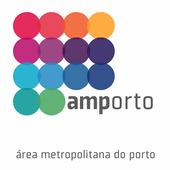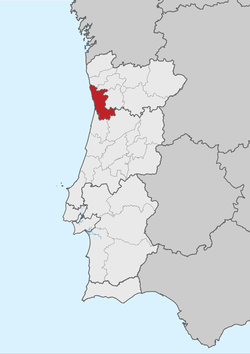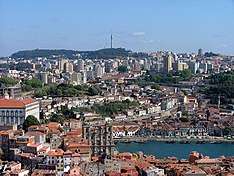Porto metropolitan area
The Porto Metropolitan Area (Portuguese: Área Metropolitana do Porto; abbreviated as AMP) is a metropolitan area in northern Portugal centered on the City of Porto, Portugal's second city.[4] The metropolitan area, covering 17 municipalities, is the second largest urban area in the country and one of the largest in the European Union, with a population in 2011 of 1,721,038 in an area of 2,040.31 km².[5][6]
Porto Metropolitan Area Área Metropolitana do Porto | |
|---|---|
.jpg) _(25976064300)_(cropped).jpg) _(cropped).jpg) _(16176378817)_(cropped).jpg) _(cropped).jpg) .jpg) Clockwise: Liberdade Square; Congregados Church; high-rises on Avenida da Boavista; view of Vila Nova de Gaia; Port of Leixões in Matosinhos; aerial view of the Porto Metropolitan Area; view of central Porto. | |
 | |
| Nickname(s): AMP logo.png | |
 | |
| Core city | Porto |
| Municipalities | Arouca, Espinho, Gondomar, Maia, Matosinhos, Oliveira de Azeméis, Paredes, Porto, Póvoa de Varzim, Santa Maria da Feira, Santo Tirso, São João da Madeira, Trofa, Vale de Cambra, Valongo, Vila Nova de Gaia and Vila do Conde. |
| Government | |
| • President | Eduardo Vítor Rodrigues (PS) |
| Area | |
| • Total | 2,040.31 km2 (787.77 sq mi) |
| Population (2018) | |
| • Total | 1,721,038[1] |
| HDI (2017) | 0.835[2] very high · 2nd |
| - GDP Per capita | €25,347 ($27,748)[3] |
| Website | Official website |
The Porto Metropolitan Area is a major economic engine in Portugal, with a very high HDI (Human Development Index) and a GDP above the European average.[7] Porto has been Portugal's largest manufacturing region since the Industrial Revolution and is home to many of the country's largest corporations.
History
The original Metropolitan Area of Porto was constituted by nine municipalities: Porto (the capital), Espinho, Gondomar, Maia, Matosinhos, Póvoa de Varzim, Vila Nova de Gaia, Valongo, and Vila do Conde. The process of enlargement:
- Arouca (joined 08/01/2005)
- Oliveira de Azeméis (joined 01/09/2008)
- Paredes (joined 12/09/2013)
- São João da Madeira (joined 08/01/2005)
- Santa Maria da Feira (joined 08/01/2005)
- Santo Tirso (joined 08/01/2005)
- Trofa (joined (08/01/2005)
- Vale de Cambra (joined (01/09/2008)
Government
The metropolitan area is governed by the Junta Metropolitana do Porto (JMP), headquartered in Avenida dos Aliados, in downtown Porto under the presidency of Hermínio Loureiro, also the mayor of Oliveira de Azeméis municipality, since the Municipal Elections held in 2013, when he succeeded Rui Rio, mayor of Porto.
The Assembleia Metropolitana do Porto (Porto Metropolitan Assembly) is composed of 43 MPs, the PSD party has 20 seats, the PS 16, the CDS 3, CDU 3 and the BE, one.
Although the government has halted the intention of creating new metropolitan areas and urban communities, it is keen to ensure greater autonomy to Porto and Lisbon metropolitan areas.
Urban areas and agglomeration
Greater Porto is the second largest metropolitan area of Portugal, with about 1.7 million people. It groups the larger Porto Urban Area, the second largest in the country, assembled by the municipalities of Porto, Matosinhos, Vila Nova de Gaia, Gondomar, Valongo and Maia. A smaller urban area of Póvoa de Varzim and Vila do Conde, which ranks as the six largest in continental Portugal. The new regional spatial planning program (PROT-Norte), recognizes both urban areas and engages in their development.[8]
There are some intentions to merge the municipalities of Porto with Gaia and Matosinhos into a single and greater municipality, and there is an ongoing civil requisition for that objective. The government also started to discuss the merging of some municipalities due to conurbations, but gave up. There is a similar idea for the conurbation of Póvoa de Varzim and Vila do Conde, and both municipalities have decided to work as if both are the same city, cooperating in health, education, transports and other areas. Several municipalities of the metropolitan area also moved closer, thus becoming a cohesive group.
The urban-metropolitan agglomeration known as Northern-western Urban-Metropolitan Agglomeration or Porto Metropolitan Arch is a regional urban system of polycentric nature that stretches far beyond the metropolitan borders, and includes circa 3 million people, which takes in other main urban areas such as Braga and Guimarães, the third and eighth largest cities (as defined by urban areas) of Portugal. The entire region of Northern-western Portugal is, in fact, a single agglomeration, linking Porto and Braga to Vigo in Galicia Spain.[8]
Population
| Municipality | Area (km²)[5] | Population (2011)[6] | NUTS III region |
|---|---|---|---|
| Santo Tirso | 136.60 | 71,530 | Área Metropolitana do Porto |
| Trofa | 72.02 | 38,999 | Área Metropolitana do Porto |
| Arouca | 329.11 | 22,359 | Área Metropolitana do Porto |
| Oliveira de Azeméis | 161.10 | 68,611 | Área Metropolitana do Porto |
| Santa Maria da Feira | 215.88 | 139,312 | Área Metropolitana do Porto |
| São João da Madeira | 7.94 | 21,713 | Área Metropolitana do Porto |
| Vale de Cambra | 147.33 | 22,864 | Área Metropolitana do Porto |
| Espinho | 21.06 | 31,786 | Área Metropolitana do Porto |
| Gondomar | 131.86 | 168,027 | Área Metropolitana do Porto |
| Maia | 82.99 | 135,306 | Área Metropolitana do Porto |
| Matosinhos | 62.42 | 175,478 | Área Metropolitana do Porto |
| Porto | 41.42 | 237,591 | Área Metropolitana do Porto |
| Póvoa de Varzim | 82.21 | 63,408 | Área Metropolitana do Porto |
| Valongo | 75.12 | 93,858 | Área Metropolitana do Porto |
| Vila do Conde | 149.03 | 79,533 | Área Metropolitana do Porto |
| Vila Nova de Gaia | 168.46 | 302,295 | Área Metropolitana do Porto |
| Paredes | 156.76 | 86,854 | Área Metropolitana do Porto |
| Total | 2,040.31 km² | 1,762,524 |
Transportation

The Metropolitan area is keen to develop its transportation network. Porto Metro is a Rapid transit system that links the municipalities of Porto, Vila Nova de Gaia, Matosinhos, Gondomar, Maia, Vila do Conde and Póvoa de Varzim.
The Porto/ Francisco de Sá Carneiro Airport / Pedras Rubras (OPO), between the municipalities of Maia, Matosinhos,and Vila do Conde, is also one of its greater investments. It was transformed from an old and obsolete airport to a modern transportation centre, linked to Porto Metro. The JMP is also trying to pressure the government to add a TGV line to link Vigo in Galicia to Porto Airport in order to make Porto the air traffic centre of the North-Western Iberian Peninsula and to tighten its historical ties with that Spanish province.
Greater Porto is served by a great number of Motorways linking the main central areas of the metropolitan region and the region with other main Portuguese cities (cidades portuguesas). Main Harbour: Leixões (Matosinhos). Motorways:
- A1 - Lisbon - Porto (North Motorway)
- A3 - Porto - Valença
- A4 - Porto - Quintanilha/Espanha
- A7 - Póvoa de Varzim - Vila Pouca de Aguiar
- A20 - Carvalhos - Nó de Francos (CRIP - Porto Inner-Ring Motorway)
- A28 - Porto - Caminha (Northern Littoral Motorway)
- A29 - Angeja - Porto
- A32 - Oliveira de Azeméis - Porto
- A41 - Perafita - Espinho (CREP - Porto Outer-Ring Motorway)
- A42 - A41 - Felgueiras
- A43 - Porto (A-20) - Aguiar de Sousa
- A44 - Gulpilhares (A29) - A20
References
- Base de Datas de Portugal - População residente: total e por grandes grupos etários
- "Sub-national HDI – Area Database – Global Data Lab". hdi.globaldatalab.org. Retrieved 2018-09-13.
- Regions and Cities > Regional Statistics > Regional Economy > Regional GDP per Capita, OECD.Stats. Accessed on 16 November 2018.
- Fernanda Paula Oliveira (2009), The Evolution and Regulation of the Metropolitan Areas in Portugal at the Internet Archive PDF (677 kB)
- "Áreas das freguesias, concelhos, distritos e país". Archived from the original on 2018-11-05. Retrieved 2018-11-05.
- Instituto Nacional de Estatística
- "Sub-national HDI – Area Database – Global Data Lab". hdi.globaldatalab.org. Retrieved 2018-09-13.
- Plano Regional de Ordenamento do Território da Região Norte Archived 2009-09-20 at the Wayback Machine - July 2009
External links
| Wikimedia Commons has media related to Área Metropolitana do Porto. |
- Official website (in Portuguese)
